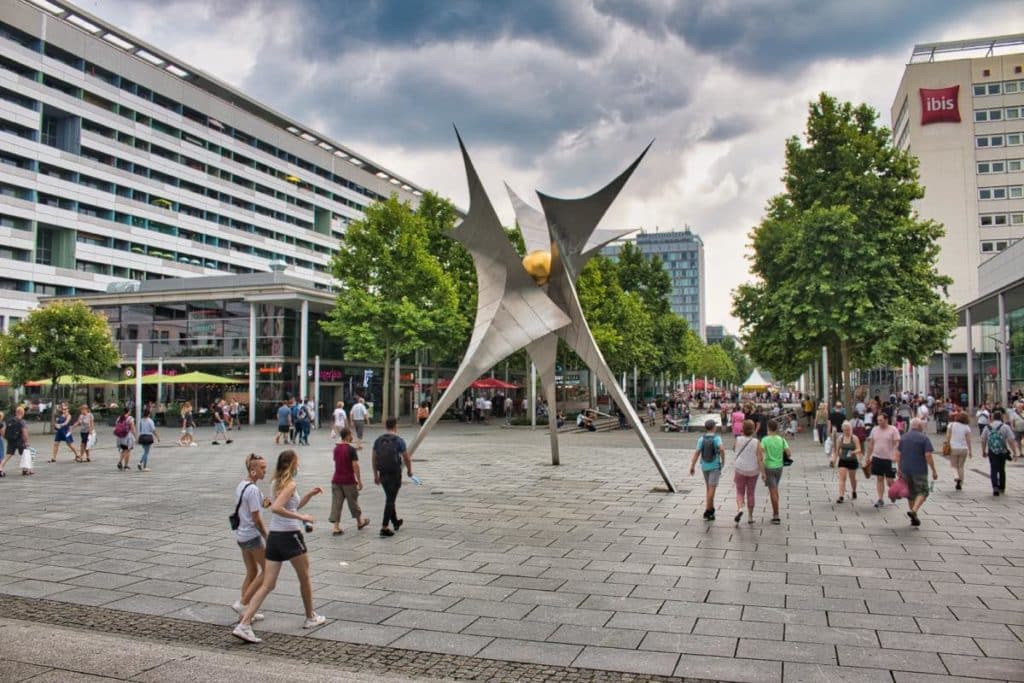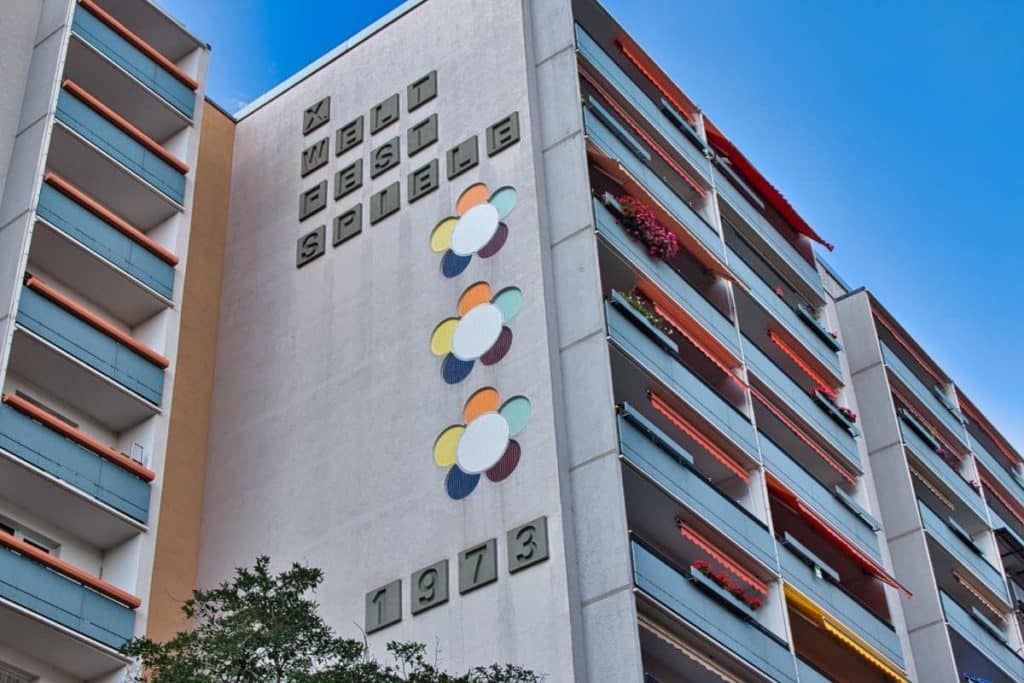The GDR in Dresden – you would think it had never existed. Dresden lay in ruins after the devastating bombing raids of February 1945. Much was built up in the 40 years of “real existing socialism”. And even though a few buildings are among the prominent Dresden landmarks, there is hardly anything left of the GDR in Dresden today.
Important GDR buildings have disappeared, others have been core renovated and lost their striking appearance. And even the prefabricated buildings – the face of the GDR in concrete – have been polished to such an extent that you might think many of them were built after the fall of the Wall. Nevertheless, we have gone in search of traces and have explored for you the most exciting places that still exist from the GDR in Dresden.

Prager Straße
It was the showpiece of GDR architecture in Dresden. Prager Straße (Prague Street) was to be the best that the architects of the Republic’s planning offices could create. After the buildings on Prager Straße had been completely destroyed in the 1945 bombing raids on Dresden, the goal was to create an airy development with taller houses and many functional buildings that would connect the main railway station with the banks of the Elbe and the other sights of the old town. In the process, some of the most significant buildings of GDR architecture were actually created in Dresden, indeed in the GDR as a whole.

Interhotel Newa
The Interhotel Newa was the first of the hotels to open on Prager Straße. The name Newa referred to the river in what was then Leningrad, Dresden’s Soviet twin city. The 15-storey building was one of the tallest in the city. The most striking feature was the aluminium curtain façade, which has since been removed. Today, the hotel is called Pullman Dresden Newa*.

Rundkino (Round cinema)
The Rundkino from 1972 is probably the most unusual and futuristic building on Prager Straße. The 50-metre diameter building was the most modern cinema in Dresden at the time. Today it still has the largest screen in Saxony and continues to function as a cinema, although it has been considerably modernised on the inside.

Hotels Bastei, Königstein and Lilienstein
The hotels, which are named Bastei, Königstein and Lilienstein, were initially opened in 1969 as Interhotels Prager Straße. They are named after rocks in Saxon Switzerland. The Hotel Bastei* was considered a holiday hotel for trade union members of the FDGB (Trade Union Federation in the GDR). The Königstein and Lilienstein hotels also accommodated foreign guests. The twelve-storey buildings have been renovated since reunification and two now function as hotels, one as a private student residence.
Pusteblume-Brunnen (Dandelion fountain)
The dandelion fountain is probably the best known fountain in Dresden. It consists of five steel stands with tips that look like dandelions and five mushroom-shaped stands. It was created in 1969. Today, however, the fountain only stands with three dandelions in Prager Straße.

Residential building Prager Zeile
Opposite the hotel windows, one of the longest residential buildings in Germany was already built from 1965 to 1967, which became known as Prager Zeile. More than 1000 people lived here in 561 flats. The architects drew on ideas by Le Corbusier for the design. In 2007, the building was renovated and given an aluminium façade that greatly changed its appearance.

Centrum Department Store
The Centrum Department Store was not completed until 1978, being the last of the larger buildings on Prager Straße. Some of the building shell had already been standing on this site for several years. The aluminium façade of the department store was considered one of the most beautiful in Germany and was a symbol of modernism in Dresden archotecture. Nevertheless, the building was demolished in 2008. A modern shopping gallery was built in its place. However, the façade of the building was preserved and integrated into the new building.

Kulturpalast Dresden
The Dresden Palace of Culture (Kulturpalast) is something like the little brother of the Palace of the Republic in Berlin. Here there was not only a hall with around 2500 seats, but also a studio theatre, rehearsal rooms and a restaurant. In the course of a refurbishment, the hall was modernised and has shrunk somewhat. Dresden City Library also maintains a branch here. Access is also possible at weekends.
The mural “Our Socialist Life” is still emblazoned on the first floor. From the upper floor with its huge glass front, you have a great view of the Altmarkt. You can also visit the concert hall on guided tours.

Mural “The Path of the Red Flag”
On the west side of the building, the huge mural “The Path of the Red Flag” has been emblazoned since the building was built. It measures 10.5 x 30 metres and was created by a working group of the Dresden Academy of Fine Arts on the occasion of the 20th anniversary of the GDR in 1969.

Mural “World Youth Festival”
In 1973, the World Youth Festival took place in East Berlin. For the leadership of the GDR, this was a welcome occasion for propaganda measures throughout the country. Posters advertised the meeting of young people and students everywhere, mainly from socialist countries. In Dresden, too, a mural for the World Youth Festival was put up on the façade of a prefabricated building on today’s Günzplatz. It has survived all renovations so far.
Museum “The World of the GDR”
Formerly run as a private GDR museum in Radebeul, “The World of the GDR” has now moved to Dresden’s Neustadt district. All kinds of things from everyday life in the GDR are exhibited here on Albertplatz. Furniture, everyday objects, vehicles – former GDR citizens and other guests embark on a journey back in time here for 7 euros. Unfortunately, the descriptions are not exactly lavish, so the exhibition is less interesting for visitors without in-depth knowledge of the GDR.
Bautzner Straße Memorial Site
The Stasi maintained at least one prison for political prisoners in each district. In Dresden, this was located on Bautzner Straße, not far from today’s Waldschlösschenbrücke. Here, the State Security interrogated and interned disagreeable persons. They were often only released after years of imprisonment or after being ransomed by the Federal Republic of Germany. The exhibition explains all the procedures and everyday life of the prisoners from admission to release. The 6 euro entrance fee is worth it to get to know authentic testimonies from a world that is the subject of the film The Lives of Others, that even win an Oscar.

Dresden TV Tower
One of the least noticed testimonies of the GDR in Dresden architecture is the TV Tower. Since it stands quite far from the city, few visitors stray here. Built on the slopes of the Elbe between 1964 and 1969, its 252-metre height places it in the top 10 of Germany’s tallest television towers. It was even number 2 in the GDR. When the GDR’s Deutsche Fernsehfunk (DFF) began broadcasting, Dresden was difficult to reach because of its valley location. Dresden was generally penalised in radio reception, because even West German television and radio could only be received via medium or long wave. This also earned Dresden the nickname “Valley of the Clueless”.
The TV tower was opened on the 20th anniversary of the GDR on 7 October 1969. From then until 1991, the tower was a popular destination. There was a restaurant with 120 seats at a height of 145 metres and a viewing platform above. Currently, the city is looking for tenants who would take over the TV tower.
Note: Of course, we make no claim to completeness with this article. But we would be happy if you write us in the comments where you can find more remnants of GDR architecture in Dresden!
No products found.
No products found.
No products found.
No products found.
No products found.

